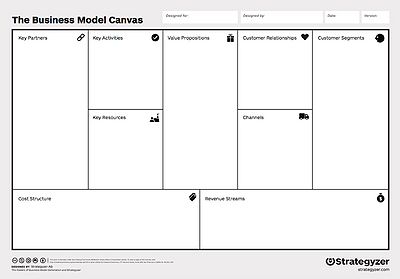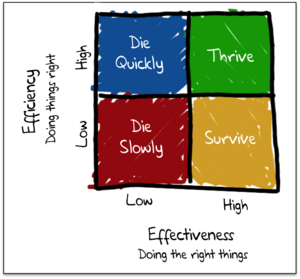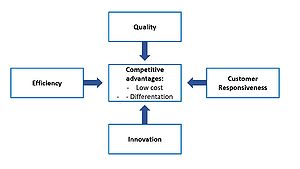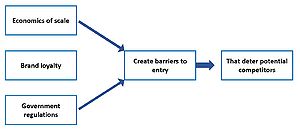Use of Business Model Canvas to Kickstart the project management
Abstract
To start a project, it is important to have a clear scope. A tool that is often used is the Business model canvas, both to start up a project within an existing company or to start up a new company. The business plan can be more or less comprehensive, but the more it is well thought out the higher is the chance of success. A typical method to create a business plan is to use the Business model canvas and therefore this article examine the incooperation of the business model canvas to project managing. The execution of information transfer from the Business Model Canvas to start of project management will be described in detail.
The two main project developement methodologies considered in this paper are waterfall and agile. Waterfall is a sequential based method whereas agile is based on iterations. Choosing between these two methods will affect the use of the business model canvas. For detailed explanation read Waterfall vs. Agile Methodology. The affect of working by the agile or waterfall method is described and then all similar methods for both agile and waterfall is explained.
The similar methods are some generel management tools typical to start the process of managaging and the main focus from the Business Model Canvas is in key activities, key ressources, value proposition and customer segment.
First you will find a very brief description of the Business Model Canvas.
Contents |
Business Model Canvas
The business model canvas is a tool to scope the changes in a company or the startup of a company. This will result in either adding information to an empty canvas or to outline changes from an old business plan to a new one. The Business Model Canvas describes 9 blocks of valuable knowledge to investigate before starting a business. Those 9 blocks and their relation can be seen from figure XX and describe following:

Key partners The network of suppliers and partners of the project or company and a description of resources and activities connected to each of them. [2]
Compared to project management - Key partners are much more focused for business model and for project management and would be compared to stakeholder management. For business model canvas the focus is to identify and for project management to understand. Key partners are similar for agile and waterfall. [2]
Key activites A description of what jobs will make the business work according to the other blocks. This can be production, problem solving and platforms.[2]
Compared to project management - Key activities in business model is the are the necessary activities to produce a product and for project management key activities are more detailed and describes all activities to get to produce the product.[2]
Key resources Key resources describes what resources are most important to get the business to perform well. These can be financial, human, physical and/or intellectual.[2]
Cost strudtures A description of all costs for operation of the project, including cost for activities and resources.[2]
Value propostions Description of products and services that can create value for a customer segment. The value proposition has a high variation of possible value types, as example it can be in form of performance, customization, design and/or cost reduction. The value can also be a mix of several types of values.[2]
Customer relationship Describes the relationship the company has to the costumer segment. As examples it can be a very close dedicated personal assistance, or it can be self-service which require no direct communication between company and costumer segment.[2]
Channels The channels describe how a company, or the project reaches the customer segment.[2]
Customer segment The groups of people the project or company aims to reach and serve. Two examples of costumer segments are mass market and niche market.[2]
Revenue streams The block describes how cash is generated in the project or company. The description includes an analysis of what costumers are willing to pay for the value that is offered.[2]
Affect of Business Model Canvas for waterfall method compared to agile method
Working by the method of the waterfall model, increase the need of information right from the beginning of managing as it does not have a feedback structure. To be able to perform as good as possible a coherent analysis of a given project will be necessary in the start of managing a project to avoid any mistakes made from the start. Any mistakes in the analysis will just follow along in the waterfall method. Typical the waterfall method works well if the business plan is all done and is not to be changed again. Changing the business plan will mst likeliy cause the project managing to start over. So the business model can support the managing of a project working by the waterfall method, but the project managing work will not support the business model. The agile method consists of iterations and will be able to correct any mistakes, so a thorough investigation is not as crucial as for the waterfall method, though it will still be a huge help and save both time and money. The agile method does make it possible to correct in the Business Model Canvas, so the project managing will also support the business model as well as the business model support the project managing.
Kickstarting the project managing
Project management starts by a comprehensive analysis of several aspects of a project. This analysis can be strongly supported by the Business Model Canvas for the use of many typical models used for managing, as the key stakeholders are outlined, the key resources, cost plan, goals and costumer segment are already defined. Some of the typical models used during the analysis phase is as follows and will be the same for starting managing whether the waterfall or agile method is used.
Efficiency/effectiveness
This can be used to clarify whether the project is efficient and effective. To be able to succeed the project work must be effective, in ineffective work will cause the death of the project fast or slow depending on how efficient the work is. Being effective means pursuing the right goals, so it is crucial to clarify the goals of a project. The overall business plan helps to set the goal and the value proposition canvas is quite specific of the goal, though the goal will be phrased differently.
Example 1 - The value proposition could be to deliver high quality designer clothes to a niche market, then the goal is to design high quality designer clothes.
Example 2 – The value proposition is to deliver cheap fast food bought in supermarket and ready to eat and to reach a wide costumer segment. The goal for this example is to create a cheap production of food that apply to a wide range of customers and with a high production rate.
If the project pursues the right goals it will be effective and it will have a high chance of succeed, though if it is inefficient it will be at a high cost. Being efficient is utilizing one’s resources wisely. All key resources are defined from the business model canvas and makes it possible for the manager to prioritize resources and therefore efficiently take use of them, and they can be attached to the activities described in key activities. Though further activities will be relevant for project management as described for key activities.
Example 1 – If the key resources are humans their activities and procedure must be optimized.

Building competitive advantage
Competitive advantage are succeeded when the four elements quality, efficiency, costumer responsiveness and innovation are reached and will result in low cost and/or differentiation.
Quality The quality of the project can be discussed and decided based on the value proposition. Example 1 – If the value proposition is to deliver designer clothes to a niche market, the quality needs to be of high standards as well as the price will be higher. Example 2 - If the value propositions is to deliver cheap fast food in supermarkets, then the quality not necessarily needs to be of high standards if the cost is low.
Efficiency Efficiency is as described for efficiency and effectiveness. Organizations compete in new ways to improve the use of recourses and reduce the quantity of them, therefore it is important for a company to achieve competitive advantages [4].
Customer responsiveness To be able to attract customers it is important to know their needs and respond to that. This information input can be found in the customer segment and the value proposition and it must be analyzed whether the value proposition does respond to the customer segment for the organization. Example 1 – If the value proposition are designer clothes and the customer segment are a niche market, it must be investigated what kind of designer clothes is already offered, what this specific niche market desire in clothes and what is not offered yet.
Innovation Innovation is to create new or improved products or to develop new ways to produce or provide them[4] . Innovation will create value for a business, but the resources used to come up with innovation ideas must be minimized relatively to the business plan in order for it to pay off. Therefore, the key partners, key resources, key activities, value proposition, channels, customer relationship, the customer segment and cost revenues all influence how to focus on innovation. Depending on who the key partners are, they might bring input and resources to innovation ideas, all other blocks can be optimized, and the business plan can be innovated and a wide range of possibilities. So when investigating innovative methods and possibilities, the business model is a great starting point and will kickstart the brainstorm of options. Example 1 – Designing high quality clothes for a niche market. To bring innovation to such kind of a business, can be done in multiple ways. First, key partners must be taken in to considerations. Does the business have any key partners that support innovative ideas, and do they already provide innovative ideas in other business which can support business of designer clothes? Then the innovative idea can be by improvement of activities and resources. It can also be by improving the value proposition, channels, customer relationship and customer segment. So instead of just designing clothes, the clothes can be designed with inputs from the niche market, which will affect the value proposition, the customer relationship and maybe also the channels. The cost revenues can also be improved and innovative ways can be invented. Innovation will often be a rethinking of several aspects of the business model. As described in example 1, developing new ways to produce products will include both resources and activities.

Barriers to entry
Barriers to entry are the description of how difficult it is to enter a market, and by that it also defines how many competitors there will be [4]. To define the barriers to entry a market three inputs must be considered, Economics of scale, Brand loyalty and government regulations.
Economomics of scale Economics of scale is the cost advantages based on a large production of goods or services.[4] This is related to the customer segment that can aim for anything in between the mass market and niche market. If the organization aim for the mass market it must be observant for any competitors, because leading companies in mass market productions create high barriers for that specific market.
Brand loyalty If there are already companies in a market with high brand loyalty it will take a lot of effort to convince customers to go for a new product or service. At the same time if the market is already entered then creating a high brand loyalty will increase the change for the organization to survive. For both cases the customer relationship and the channels of the product influence the brand loyalty.
Government regulations Does not have any real inputs from the business model. So to define the barriers there is to enter a market, the customer segment, the customer relationship and the channels described by the business model will contain supporting material.

Limitations to be aware of when including the BCM in project managing
It is important to be aware that even with all the similarities in the business models canvas and the analyzing phase of project management it is not the same inputs for several of the business model canvas as it is for project management. The business model must only be considered support for the beginning phase of project management and not considered to contain any final results for managing. Key partners are not the same as stakeholders and the stakeholder analysis is much more comprehensive. Key partners are those who is part of the project by bringing ressources, whereas stakeholders are anyone that can influence of be influenced by the project. The key activities differs between the business model and project management, again because the project management needs a much more comprehensive analysis of activities and include all activities that takes part of getting the project started and in the business model it only contain activities necessary to keep the project going. The business model canvas outlines what is the desire for the business, and it brings in an overview of whether all aspects relates to eachother in a reasonable way. For example if the value proposition is to produce cheap fast food and the customer segment is a niche marketm, then there is a misalignment due to the fact that producing it to be cheap require the amount of sold products to be high. So, when creating a business model, it does some of the job for the project manager and will give less work to get the business started. Project managing will then use the information but make a more thorough analysis of the organization.
Annotated bibliography
Jones, G. R., & George, J. M. (2015). Essentials of contemporary management (4th ed.) New York, NY: McGraw-Hill Education. - The book presents the business model canvas and a description of how to use it. The book is created as a handbook for whom I concern, with several examples and explanations presented with few words and lots of illustrations. A lot of visual communication is used to present the content.
Osterwalder, A., Pigneur, Y., Clark, T., & Smith, A. (2010). Business model generation: A handbook for visionairies, game changers, and challengers. Hoboken, NJ: Wiley. - A rather comprehensive examination of contemporary management is to by find in this book. It describes several aspects of management and what the role of being a manager contains. It introduces a lot of typical management tools and explain the use of them in management. In each chapter an example of management is given corresponding to the topic of the chapter. A thorough description of the tasks, responsibilities and tools necessary to know when being a manager.
References
- ↑ https://www.strategyzer.com/
- ↑ 2.00 2.01 2.02 2.03 2.04 2.05 2.06 2.07 2.08 2.09 2.10 Jones, G. R., & George, J. M. (2015). Essentials of contemporary management (4th ed.) New York, NY: McGraw-Hill Education.
- ↑ https://agilebacon.com/words-mean-things-efficient-and-effective/
- ↑ 4.0 4.1 4.2 4.3 4.4 4.5 "Jones, G. R., & George, J. M. (2015). Essentials of contemporary management (4th ed.) New York, NY: McGraw-Hill Education."